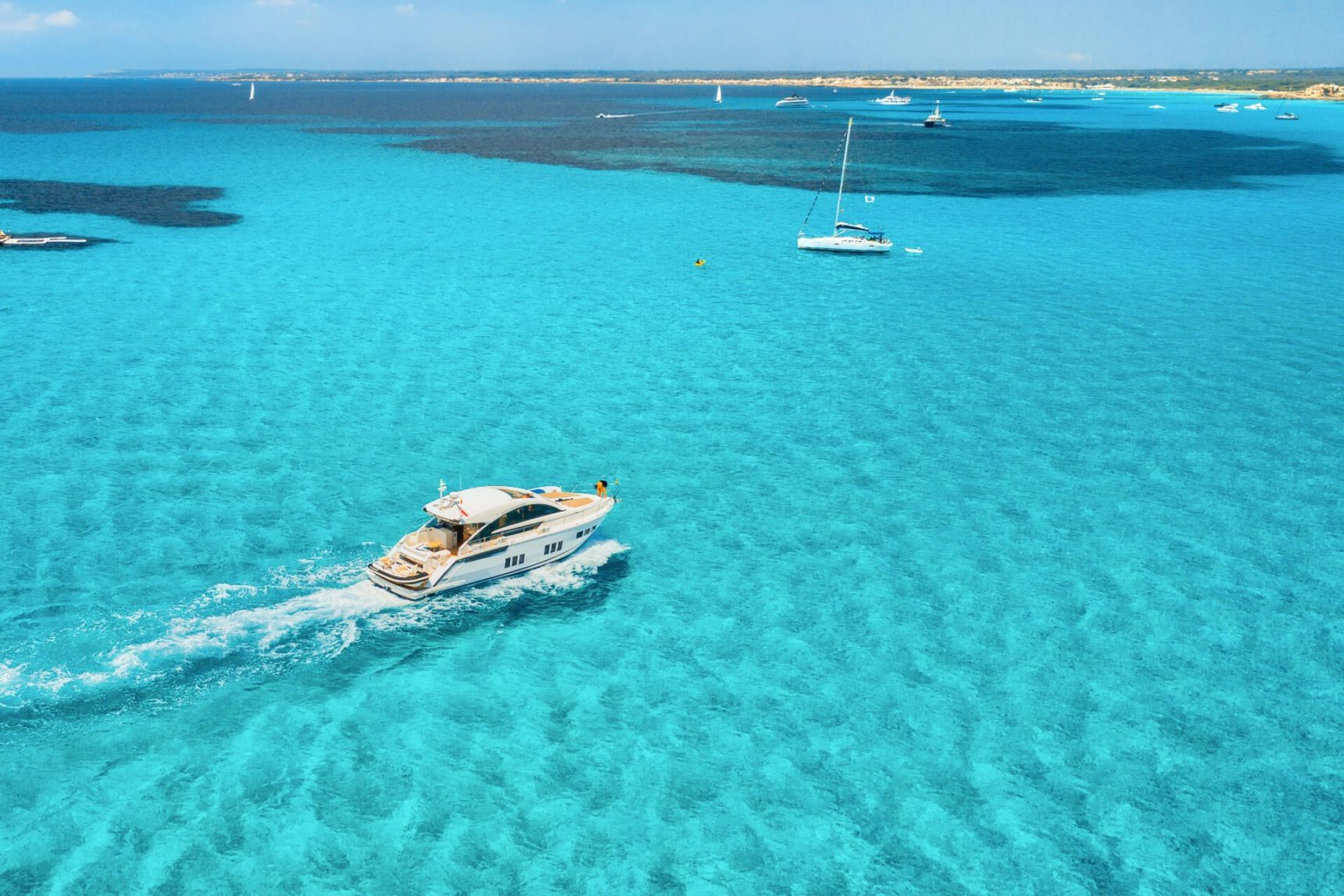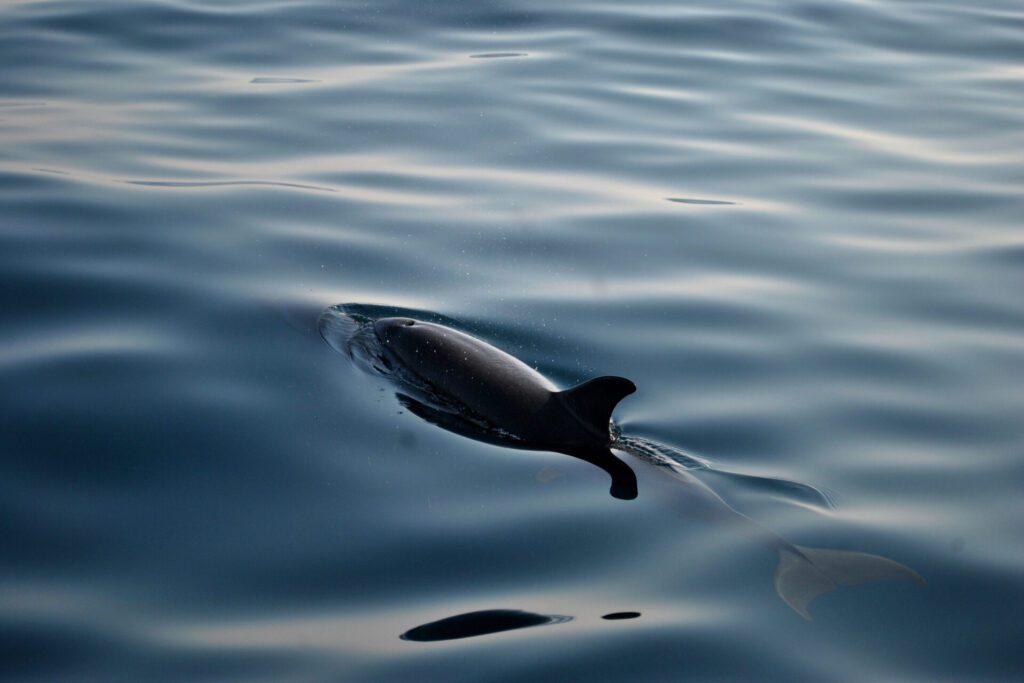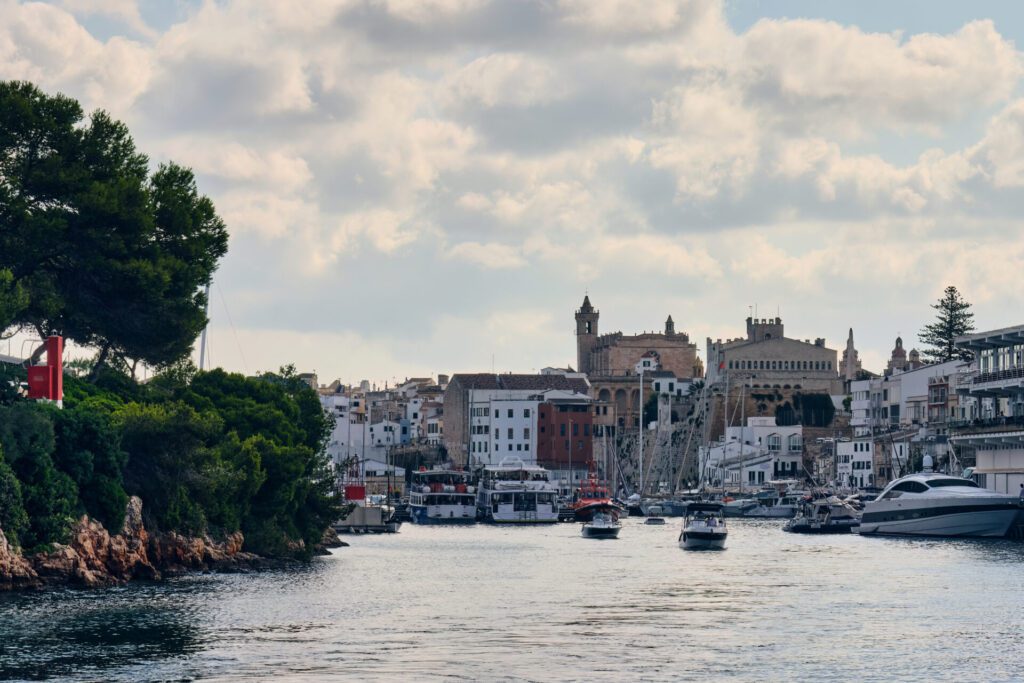“Freedom consists in being masters of one’s own life.” Plato.
And for that, nothing better than taking the helm and setting up your crossing from Mallorca to Menorca on your own or rented boat. It is a unique experience that offers the freedom to explore the Mediterranean at your own pace being the absolute protagonist.
If you are an adventurer and you are planning this crossing, keep reading because we are going to give you all the information you need to get to port.
Let’s go there!
What is the best time for the crossing?
The best time to make the itinerary from Mallorca to Menorca by boat is between May and September.
During these months, the weather is more stable and the sea conditions are ideal for sailing. The prevailing winds in summer are gentle and constant, which facilitates a calm and safe crossing.
The warm weather and long hours of sunshine allow you to enjoy outdoor activities, both en route and once you arrive in Menorca. I
n addition, the water temperature is perfect for swimming and water sports. It is important to keep in mind that July and August are the busiest months for tourists, which can mean more maritime traffic and busier ports. If you are looking for a quieter experience, May, June and September are excellent options, offering an ideal balance between good weather and lower visitor density. Before departing, it is essential to check weather forecasts and sea conditions to ensure a safe trip. It is also highly recommended to book in advance at the ports of Menorca, especially during the high season.
Another interesting point of making the trip in the summer months is that during the summer, both in Mallorca and Menorca, several festivities are celebrated that can make your trip even more fun.
Events and Festivities in Mallorca (from May to October)
| Month | Event/Festivity | Description |
| May | Fira de Maig en Inca | Agricultural and livestock fair with samples of local crafts and typical products. |
| June | Noche de San Juan | Celebrations with bonfires and fireworks on beaches and squares all over the island. |
| End of June/July | Deià International Music Festival | Classical music concerts in the picturesque village of Deià. |
| August | Festa de Sant Bartomeu en Sóller | Festivities with parades, fireworks and cultural activities. |
| September | Fira de la Llampuga en Cala Ratjada | Gastronomic fair centered on the local fish called llampuga. |
| October | Fira de la Tardor en Porreres | Autumn fair with local products, exhibitions and traditional activities. |
Events and Festivities in Menorca
| Month | Event/Festivity | Description |
| June | Fiestas de San Juan | Celebrated in Ciutadella, including horses, parades and fireworks. |
| July and august | Festival de Música de Verano de Menorca | Music concerts (different styles) in different towns. |
| august | Fiestas de Sant Llorenç | Traditional festivities in Alaior with horse parades and cultural activities. |
| septiember | Fiestas de la Mare de Déu de Gràcia | Festivities in Mahón with processions, music and fireworks. |
| octuber | Fira del Camp | Agricultural and livestock fair in Es Mercadal. |
Crossing planning: from Mallorca to Menorca during the summer months
Planning a boat trip from Mallorca to Menorca during the summer months requires careful preparation to ensure a smooth and pleasant crossing. Here we provide you with a guide with the most important aspects to consider:
Necessary preparations before departure
- Documentation and permits: Make sure you have a valid license to operate the type of vessel you will be using. Verify that the vessel’s registration documents are up to date. Make sure you have adequate insurance to cover possible incidents at sea.
- Check and maintain the boat: Perform a complete inspection of the engine and electrical systems. Verify the availability and condition of life jackets, flares, fire extinguishers, and first aid kit. Make sure you have a functional GPS, updated nautical charts and communication systems such as VHF radio.
What to take on the boat
- Essential navigation equipment Marine GPS: Fundamental for precise navigation. Nautical Charts: Updated maps of the areas you are going to navigate. VHF Radio: For communications and emergencies. Compass: Basic navigation tool. Nautical Sounder: To measure the depth of the water. Binoculars: Useful for observing from a distance.
- Basic and emergency supplies, drinking water: Take enough for the whole crew during the trip and an extra in case you are delayed for any reason. Non-perishable food: Energy bars, nuts, crackers, and canned and preserved foods. First aid kit: Include basic medicines, bandages, disinfectants and any necessary personal medication. Life jackets: Make sure you have one for each person on board. Flares and emergency signals: To alert other boats or rescue teams. Fire extinguisher: Make sure it is in good condition and accessible. Emergency knife: Useful in many situations.
- Recommended clothing and accessories Light clothing: Comfortable and cool clothing for the day, such as cotton T-shirts and shorts. Sun protection clothing: Long-sleeved shirts with UV protection, hats and caps. Warm clothing: A light jacket or windbreaker for cooler evenings. Swimwear: To enjoy the sea during the crossing. Non-slip footwear: To move safely on the deck of the boat. Sunscreen with a high sun protection factor, ideally water resistant. Sunglasses Towels and blankets to dry off after swimming and keep warm on deck.
Safety at sea
Safety at sea is paramount when sailing between islands. Here is a guide with safe navigation tips, protocols in case of emergency and useful tools for navigation.
Tips for safe navigation
- Before setting sail, plan your route step by step and make sure you know the landmarks and potential hazards.
- Check weather conditions before and during the voyage.
Avoid sailing in adverse conditions. - Make sure you have life jackets for all crew members and safety equipment such as flares, fire extinguishers and a first aid kit, as mentioned above.
- Carry a VHF radio so you can communicate with other boats and shore stations. Keep a cell phone charged and in a waterproof bag.
- If you plan to sail at night, make sure all navigation lights are working properly and have a powerful headlamp handy.
- Always keep a safe distance from other vessels and marine structures.
Emergency protocol
- In the event of an emergency, it is crucial to remain calm in order to make clear and effective decisions.
- Use the VHF radio to issue a Mayday call and provide your exact location and details of the emergency.
- If necessary, use flares or emergency lights to signal your position to other boats or rescue teams.
- Make sure all crew members are wearing life jackets and are in a safe place on the boat.
- If there is a leak or fire, try to control the situation using the equipment available on board (bilge pumps, fire extinguishers).
Tools and applications for navigation
- Marine GPS: GPS devices such as Garmin or Raymarine are essential for accurate navigation and route planning.
- Weather apps: Apps such as Windy, WeatherPro and AccuWeather provide real-time weather updates, including wind speed, waves and general conditions.
- Navigation and nautical charts: Apps such as Navionics and C-Map provide detailed, up-to-date nautical charts and route planning functions.
- AIS (Automatic Identification System): Tools such as MarineTraffic allow you to track the position of other nearby vessels in real time.
- Communications Apps: Apps such as WhatsApp can be useful for keeping in touch whenever there is coverage.
Recommended routes
In the following table we recommend the three best route options for the crossing from Mallorca to Menorca by boat.
| Route | Approximate Distance | Estimated Travel Time | Features |
| Direct route Alcudia – Ciutadella | 39 nautical miles | 3-4 hours | The shortest and most popular route. Ideal for a fast crossing. |
| Rute Palma – Mahón | 70 nautical miles | 6-8 hours | Longer and more picturesque route, ideal for enjoying the scenery. |
| Rute Cala Ratjada – Fornells | 47 nautical miles | 4-5 hours | Offers an intermediate crossing with anchoring options along the way. |
Below, we tell you a little more about each of them:
Route 1: Alcudia – Ciutadella
The direct route between Alcudia, in the north of Mallorca, and Ciutadella, in the west of Menorca, is the shortest and most popular for sailors.
Features:
- Wind and waves: Generally, this route has favorable weather conditions in summer, with prevailing winds from the east and southeast.
- Scenery: It offers spectacular views of both islands as you approach land.
- Port services: Both Alcudia and Ciutadella have well-equipped marinas, with full services for refueling, maintenance and provisioning.
- Navigation: This is a relatively straightforward crossing, suitable for sailors with basic to intermediate experience.
Route 2: Palma – Mahón
The route from Palma, in the southwest of Mallorca, to Mahon, in the east of Menorca, is a longer but very scenic option.
Features:
- Wind and waves: Sailing along this route can expose you to shifting winds, but in summer conditions are usually stable.
- Scenery: It offers breathtaking views of the open Mediterranean and the possibility of spotting marine wildlife.
- Port services: Palma is one of the largest and most complete ports in the Mediterranean, while Mahon offers a spectacular entrance to Europe’s largest natural harbor, with excellent services.
- Navigation: Requires more planning and experience due to the greater distance and the possibility of changing weather conditions.
Route 3: Cala Ratjada – Fornells
This route connects Cala Ratjada, in the northeast of Mallorca, with Fornells, in the north of Menorca, and offers an intermediate crossing in terms of distance.
Features:
- Wind and waves: The sea conditions on this route are usually calm during the summer, with predominantly easterly winds.
- Scenery: The crossing allows you to enjoy the northeast coast of Mallorca and the north coast of Menorca, including protected areas and marine reserves.
- Port services: Cala Ratjada and Fornells are smaller and quieter than the main ports, but offer adequate services and a more relaxed atmosphere.
- Sailing: A good option for sailors looking for a balance between a fast crossing and a more relaxed experience.
As we have seen, sailing from Mallorca to Menorca on your own or chartered boat allows you to enjoy the freedom to explore the Mediterranean at your own pace.
The best time for this crossing is from May to September, when the weather is more stable and the sea conditions are ideal. Before setting sail, make sure you have all the necessary documentation and permits, carry out a complete check of the boat and bring the essential equipment and supplies for navigation. Always remember to prioritize safety at sea, plan your route, check weather conditions and follow emergency protocols if necessary.


